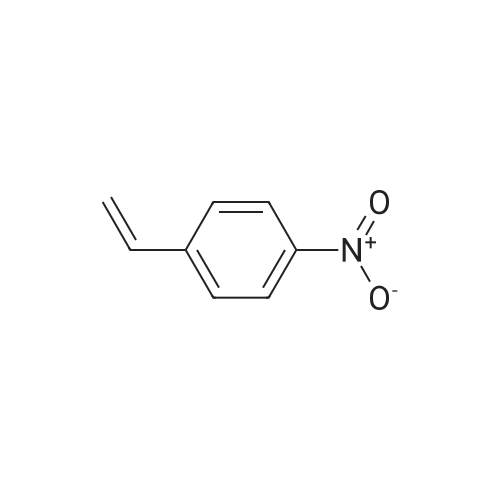Cat.NO.:A200602 Purity:95% (stabilized with TBC)
Product Details of [ 100-13-0 ]
| CAS No. : | 100-13-0 |
| Formula : |
C8H7NO2 |
| M.W : |
149.15
|
| SMILES Code : | C=CC1=CC=C([N+]([O-])=O)C=C1 |
| MDL No. : | MFCD00041254 |
| InChI Key : | YFZHODLXYNDBSM-UHFFFAOYSA-N |
| Pubchem ID : | 7481 |
Safety of [ 100-13-0 ]
| GHS Pictogram: |  |
| Signal Word: | Warning |
| Hazard Statements: | H302-H315-H319-H335 |
| Precautionary Statements: | P261-P305+P351+P338 |
Computational Chemistry of [ 100-13-0 ] Show Less
Physicochemical Properties
| Num. heavy atoms | 11 |
| Num. arom. heavy atoms | 6 |
| Fraction Csp3 | 0.0 |
| Num. rotatable bonds | 2 |
| Num. H-bond acceptors | 2.0 |
| Num. H-bond donors | 0.0 |
| Molar Refractivity | 45.36 |
| TPSA ?
Topological Polar Surface Area: Calculated from |
45.82 Ų |
Lipophilicity
| Log Po/w (iLOGP)?
iLOGP: in-house physics-based method implemented from |
1.85 |
| Log Po/w (XLOGP3)?
XLOGP3: Atomistic and knowledge-based method calculated by |
2.78 |
| Log Po/w (WLOGP)?
WLOGP: Atomistic method implemented from |
2.13 |
| Log Po/w (MLOGP)?
MLOGP: Topological method implemented from |
1.44 |
| Log Po/w (SILICOS-IT)?
SILICOS-IT: Hybrid fragmental/topological method calculated by |
0.43 |
| Consensus Log Po/w?
Consensus Log Po/w: Average of all five predictions |
1.73 |
Water Solubility
| Log S (ESOL):?
ESOL: Topological method implemented from |
-2.79 |
| Solubility | 0.243 mg/ml ; 0.00163 mol/l |
| Class?
Solubility class: Log S scale |
Soluble |
| Log S (Ali)?
Ali: Topological method implemented from |
-3.4 |
| Solubility | 0.0596 mg/ml ; 0.0004 mol/l |
| Class?
Solubility class: Log S scale |
Soluble |
| Log S (SILICOS-IT)?
SILICOS-IT: Fragmental method calculated by |
-2.21 |
| Solubility | 0.93 mg/ml ; 0.00624 mol/l |
| Class?
Solubility class: Log S scale |
Soluble |
Pharmacokinetics
| GI absorption?
Gatrointestinal absorption: according to the white of the BOILED-Egg |
High |
| BBB permeant?
BBB permeation: according to the yolk of the BOILED-Egg |
Yes |
| P-gp substrate?
P-glycoprotein substrate: SVM model built on 1033 molecules (training set) |
No |
| CYP1A2 inhibitor?
Cytochrome P450 1A2 inhibitor: SVM model built on 9145 molecules (training set) |
Yes |
| CYP2C19 inhibitor?
Cytochrome P450 2C19 inhibitor: SVM model built on 9272 molecules (training set) |
Yes |
| CYP2C9 inhibitor?
Cytochrome P450 2C9 inhibitor: SVM model built on 5940 molecules (training set) |
No |
| CYP2D6 inhibitor?
Cytochrome P450 2D6 inhibitor: SVM model built on 3664 molecules (training set) |
No |
| CYP3A4 inhibitor?
Cytochrome P450 3A4 inhibitor: SVM model built on 7518 molecules (training set) |
No |
| Log Kp (skin permeation)?
Skin permeation: QSPR model implemented from |
-5.24 cm/s |
Druglikeness
| Lipinski?
Lipinski (Pfizer) filter: implemented from |
0.0 |
| Ghose?
Ghose filter: implemented from |
None |
| Veber?
Veber (GSK) filter: implemented from |
0.0 |
| Egan?
Egan (Pharmacia) filter: implemented from |
0.0 |
| Muegge?
Muegge (Bayer) filter: implemented from |
1.0 |
| Bioavailability Score?
Abbott Bioavailability Score: Probability of F > 10% in rat |
0.55 |
Medicinal Chemistry
| PAINS?
Pan Assay Interference Structures: implemented from |
0.0 alert |
| Brenk?
Structural Alert: implemented from |
2.0 alert: heavy_metal |
| Leadlikeness?
Leadlikeness: implemented from |
No; 1 violation:MW<1.0 |
| Synthetic accessibility?
Synthetic accessibility score: from 1 (very easy) to 10 (very difficult) |
1.64 |
Application In Synthesis of [ 100-13-0 ]
* All experimental methods are cited from the reference, please refer to the original source for details. We do not guarantee the accuracy of the content in the reference.
- Downstream synthetic route of [ 100-13-0 ]
[ 100-13-0 ] Synthesis Path-Downstream 1~10
| Yield | Reaction Conditions | Operation in experiment |
|---|---|---|
| With tetrabutylammomium bromide; potassium acetate; palladium diacetate; In N,N-dimethyl-formamide; at 80℃; for 5h;Inert atmosphere; Sealed tube; | General procedure: To a solution of tetrabutylammonium bromide (1.100 g, 3.33 mmol), potassium acetate (0.586 g, 3.57 mmol), and palladium acetate (0.025 g, 0.11 mmol) in DMF (20 mL) were added substituted iodobenzene (2.21 mmol) and 4-nitrostyrene (2.44 mmol). The reaction mixture was recharged with argon and stirred at 80C for 5 h in a sealed tube. The mixture was extracted with ethyl acetate. The organic layer was washed with saturated aqueous NaCl and concentrated in vacuo. The residue was purified by column chromatography on silica gel (petroleum ether/ethyl acetate, 10:3) to afford the intermediate substituted (E)-1-nitro-4-styrylbenzene. To a solution of stannous chloride (2.087 g, 11.05 mmol) in EtOH (20 mL) was added substituted (E)-1-nitro-4-styrylbenzene (2.21 mmol). The reaction mixture was stirred at reflux temperaturefor 4.0 h. The mixture was extracted with ethyl acetate. The organic layer was washed with saturated aqueous NaCl and concentrated in vacuo. The residue was purified by column chromatography on silica gel (dichloromethane/methanol, 10:0.1) to afford pure product. |
















Reviews
There are no reviews yet.